A Practical Approach to Condition Assessment of Asphalt-Covered Concrete Bridge Decks on Korean Expressways by Dielectric Constant Measurements Using Air-Coupled GPR
Abstract
1. Introduction
2. Background: Relative Permittivity of Concrete
3. Overview on GPR Field Survey Program
3.1. Bridge Status
3.2. Methods of Survey and Analysis
- The GPR survey should be conducted at least 24 h after the precipitations,
- The investigation should not be conducted on sunrise or sunset when the relative humidity and moisture on the road change rapidly, and
- Reference GPR signals from a steel plate for GPR signal calibration should be collected immediately before or after GPR surveying.
4. Development of a Practical GPR Signal Interpretation Method
4.1. Influence of Concrete Age and Relative Humidity of Air
4.2. Influence of Concrete Age (Service Performance Period)
4.3. A Practical Curve of Concrete Dielectric Constant in Asphalt-Covered Bridge Decks
5. Application of the Proposed Model by a GPR Field Survey
5.1. Target Bridge for the Field Survey
5.2. GPR Survey
 efflorescence,
efflorescence,  map cracking,
map cracking,  patching, in the same figure. The part of bridge decks where efflorescence was observed (marked with ‘
patching, in the same figure. The part of bridge decks where efflorescence was observed (marked with ‘ ’) exhibited high dielectric constant values. It is expected that continuous water penetration and deterioration of the inside is developing there. One interesting finding is that some damaged (or solid) regions determined from
concrete dielectric constant were interpreted as solid (or damaged) regions by visual inspection on the surface. For example, the deteriorated areas according
to the dielectric constant are mostly located near the median barrier and shoulder, where no obvious deterioration is observed by visual inspection on the surface. In contrast, the dielectric constant values in most of the traffic lanes are between the cut-off values, while there are many surface-breaking cracks in the traffic lanes.
’) exhibited high dielectric constant values. It is expected that continuous water penetration and deterioration of the inside is developing there. One interesting finding is that some damaged (or solid) regions determined from
concrete dielectric constant were interpreted as solid (or damaged) regions by visual inspection on the surface. For example, the deteriorated areas according
to the dielectric constant are mostly located near the median barrier and shoulder, where no obvious deterioration is observed by visual inspection on the surface. In contrast, the dielectric constant values in most of the traffic lanes are between the cut-off values, while there are many surface-breaking cracks in the traffic lanes.6. Conclusions
- (1)
- The influence of atmospheric relative humidity (or seasonal variation) on asphalt-covered concrete bridge decks of 2–43 years of service performance was investigated. As relative humidity changed to 10%, the dielectric constant of concrete changed to about 0.11. This is about 12% of the bare concrete bridge deck, indicating that the influence of relative humidity (air) is blocked by asphalt overlay and a waterproof layer on the concrete bridge deck.
- (2)
- Dielectric constant of concrete was found to be influenced by the service age of the bridges in most expressway routes based on the observed values of the dielectric constant of concrete in the bridges with 2–43 years of service. This pattern was similar to the bare concrete bridge decks. This study proposed a practical curve describing the variation of the dielectric constant of the top concrete of bridge decks with asphalts overlay in consideration of service life with a confidence level of 85%. Based on the proposed model and field survey experiences on Korean expressways, a double cut-off dielectric constant criterion was newly proposed for condition assessment of asphalt-covered concrete bridge decks on Korean expressways.
- (3)
- A case study of GPR application at an actual bridge on the Yeongdong expressway in Korea demonstrated that the proposed GPR signal interpretation method, based on the double cut-off dielectric constant criterion, is useful for better interpretation of concrete dielectrics and beneficial for reliable condition assessment of asphalt-covered concrete bridge decks in Korean expressways. However, the validation was obtained from only a single target bridge in Korea. Therefore, more studies are still needed to verify the validity of the practical curve and the methodology described in this study by systematic comparison researches using the data from other bridges in the field.
Author Contributions
Funding
Conflicts of Interest
References
- Ministry of Construction and Transport (MOCT). Concrete Standard Specification: Durability (42000-58821-9907); Korea Concrete Institute (KCI): Gwacheon, Korea, 2004; p. 2.
- Korea Expressway Corporation (KEC). Investigation of Aging of Bridges and Preparation of Efficiency for Unit Work (2nd Year); Korea Expressway Corporation (KEC): Hwaseong, Korea, 2015; pp. 83–112. [Google Scholar]
- ASTM. Standard Test Method for Evaluating Asphalt-Covered Concrete Bridge Decks Using Ground Penetrating Radar; ASTM International: West Conshohocken, PA, USA, 2008. [Google Scholar]
- Al-Qadi, I.L.; Lahouar, S. Measuring layer thicknesses with GPR—Theory to practice. Constr. Build. Mater. 2005, 19, 763–772. [Google Scholar] [CrossRef]
- Dinh, K.; Gucunski, N.; Kim, J.; Duong, T. Understanding depth-amplitude effects in assessment of GPR data from concrete bridge decks. NDT E Int. 2016, 83, 48–58. [Google Scholar] [CrossRef]
- Gucunski, N.; Basily, B.; Kim, J.; Yi, J.; Duong, T.; Duong, K.; Kee, S.-H.; Maher, A. RABIT: Implementation, performance validation and integration with other robotic platforms for improved management of bridge decks. Int. J. Intell. Robot. Appl. 2017, 1, 271–286. [Google Scholar] [CrossRef]
- Maser, K. Bridge deck condition surveys using radar: Case studies of 28 New England decks. Transp. Res. Rec.: J. Transp. Res. Board. 1991, 1304, 94–102. [Google Scholar]
- Varnavina, A.V.; Khamzin, A.K.; Torgashov, E.V.; Sneed, L.H.; Goodwin, B.T.; Anderson, N.L. Data acquisition and processing parameters for concrete bridge deck condition assessment using ground-coupled ground penetrating radar: Some considerations. J. Appl. Geophys. 2015, 114, 123–133. [Google Scholar] [CrossRef]
- Alani, A.M.; Aboutalebi, M.; Kilic, G. Applications of ground penetrating radar (GPR) in bridge deck monitoring and assessment. J. Appl. Geophys. 2013, 97, 45–54. [Google Scholar] [CrossRef]
- Saarenketo, T. Electrical Properties of Road Materials and Subgrade Soils and the Use of Ground Penetrating Radar in Traffic Infrastructure Surveys; Department of Geosciences at University of Oulu: Oulu, Finland, 2006. [Google Scholar]
- Varela-González, M.; Solla, M.; Martínez-Sánchez, J.; Arias, P. A semi-automatic processing and visualisation tool for ground-penetrating radar pavement thickness data. Autom. Constr. 2014, 45, 42–49. [Google Scholar] [CrossRef]
- Pajewski, L.; Benedetto, A.; Loizos, A.; Slob, E.C.; Tosti, F. COST Action TU1208 “Civil Engineering Applications of Ground Penetrating Radar” ongoing Research Activities and Mid-term Results. In Proceedings of the EGU General Assembly 2015, Vienna, Austria, 12–17 April 2015. [Google Scholar]
- Suh, J.; Lee, I.; Rhee, J. Condition Evaluation of Concrete Bridge Decks, in 98-67-65; K.H. Corporation, Highway Research Center: Seongnam, Korea, 1998. [Google Scholar]
- Suh, J.; Rhee, J.; Lee, I. Condition Evaluation of Concrete Bridge Decks by using GPR. In Proceedings of the 10th Road Engineering Association of Asia and Australasia Conference (REAAA), Tokyo, Japan, 4–9 September 2000. [Google Scholar]
- Zhang, X.; Ding, X.; Ong, C.; Tan, B.; Yang, J. Dielectric and Electrical Properties of Ordinary Portland Cement and Slag Cement in the Early Hydration Period. J. Mater. Sci. Eng. A 1996, 31, 1345–1352. [Google Scholar] [CrossRef]
- Robert, A. Dielectric Permittivity of Concrete between 50 MHz and 1 GHz and GPR Measurements for Building Materials Evaluation. J. Appl. Geophys. 1998, 40, 89–94. [Google Scholar] [CrossRef]
- Rhim, H.C.; Büyüköztürk, O. Electromagnetic Properties of Concrete at Microwave Frequency Range. ACI Mater. J. 1998, 95, 262–271. [Google Scholar]
- Rhim, H.C.; Jeong, S.H. Measurement of Electromagnetic Properties of Concrete for Nondestructive Testing. J. Korea Concr. Inst. 2000, 12, 115–123. [Google Scholar]
- Lai, W.L.; Kou, S.C.; Tasng, W.F.; Poon, C.S. Characterization of Concrete Properties from Dielectric Properties Using Ground Penetrating Radar. Cem. Concr. Res. 2009, 39, 687–695. [Google Scholar] [CrossRef]
- Rhee, J.-Y.; Kee, S.-H.; Kim, H.-S.; Choi, J.-J. Seasonal Variation and Age-related Changes in the Relative Permittivity of Concrete Bridge Decks on Korea Expressways. Int. J. Concr. Struct. Mater. 2018, 12, 35–52. [Google Scholar] [CrossRef]
- Balanis, C.A. Wave Propagation and Polarization. In Advanced Engineering Electromagnetics, 2nd ed.; John Wiley & Sons: Hoboken, NJ, USA, 1989; pp. 136–137. [Google Scholar]
- Maser, K.; Scullion, T.; Briggs, B. Use of Radar Technology for Pavement Layer Evaluation; TX-91-930-SF; Texas Department of Transportation (TxDOT): Austin, TX, USA, 1991; pp. 3–5.
- Rhee, J.; Shim, J.; Do, J.; Kim, I.; Kim, H. Advances in Evaluating Asphalt-Covered Concrete Bridge Decks Using Ground Penetrating Radar; KEC EXTRI-2018-54-534.9607; Expressway & Transportation Research Institute: Hwaseong, Korea, 2018; pp. 52–53. [Google Scholar]
- Geophysical Survey Systems, Inc. (GSSI). RADAN Version 6.6; GSSI: Salem, NH, USA, 2009; Available online: http://www.geophysical.com (accessed on 27 April 2020).
- Korea Meteorological Administration (KMA). Available online: http://www.kma.go.kr (accessed on 27 April 2020).
- ASTM D 6432-11. Standard Guide for Using the Surface Ground Penetrating Radar Method for Subsurface Investigation; ASTM International: West Conshohocken, PA, USA, 2011. [Google Scholar]
- Ang, A.H.-S.; Tang, W.H. Probability Concepts in Engineering: Emphasis on Applications to Civil and Environmental Engineering (v. 1), 2nd ed.; Wiley: Hoboken, NJ, USA, 2007. [Google Scholar]
- Rhee, J.; Kim, H.; Ock, C.; Choi, J. An Investigation of the Deterioration Characteristics of Concrete Bridge Decks with Asphalt Concrete in Korea. KSCE J. Civil Eng. 2018, 22, 613–621. [Google Scholar] [CrossRef]
- Golden Software, LLC. Available online: https://www.goldensoftware.com/ (accessed on 27 April 2020).
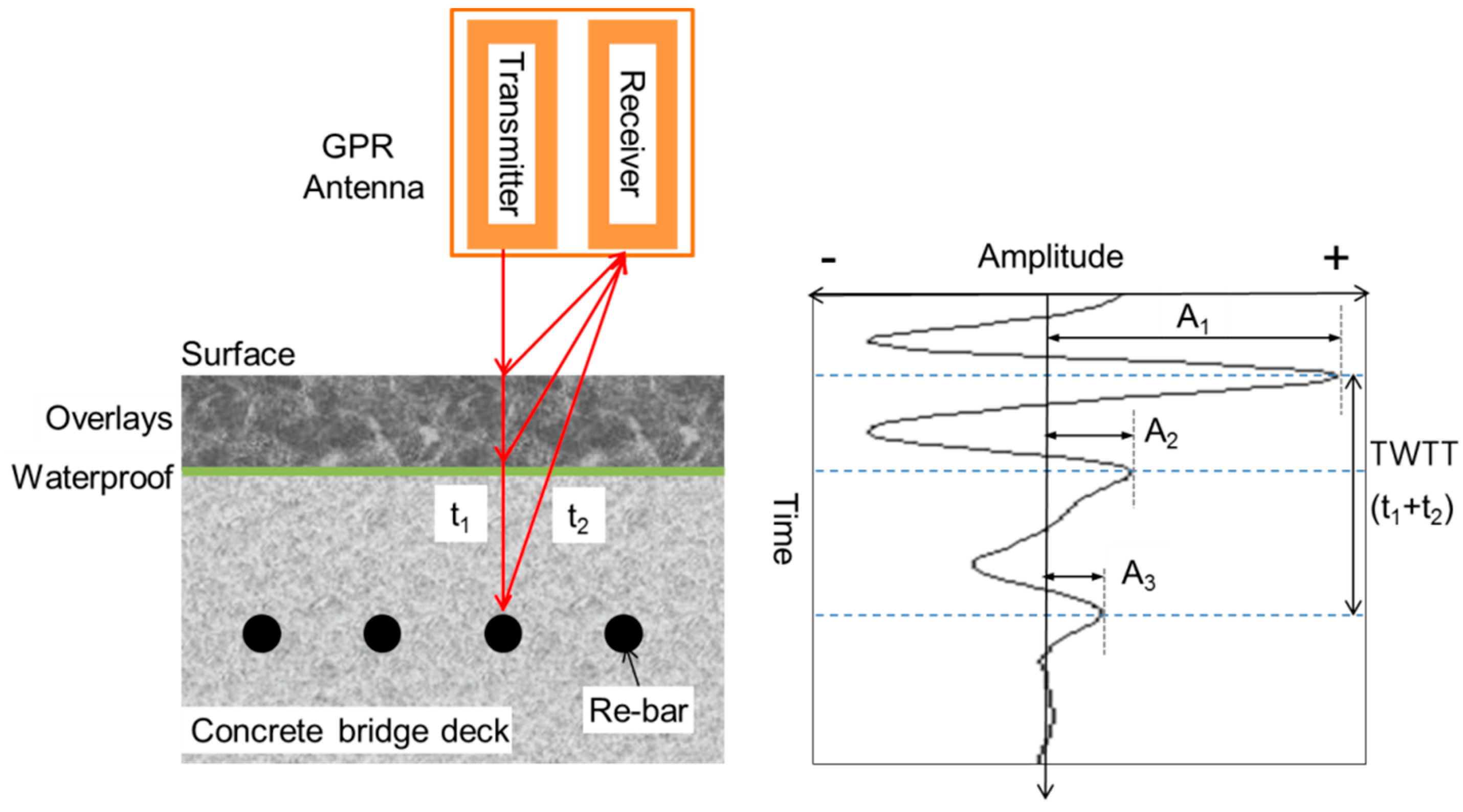
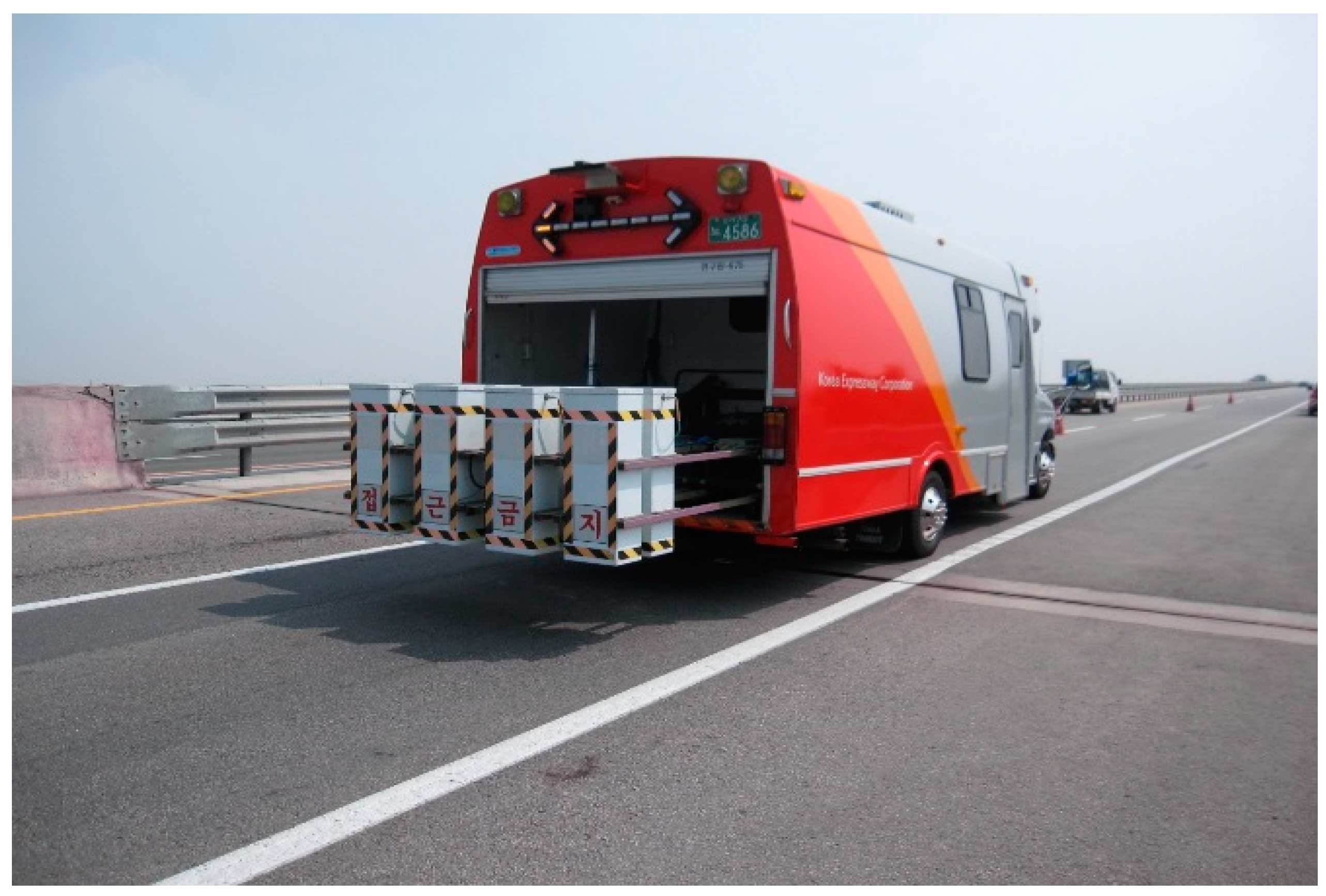

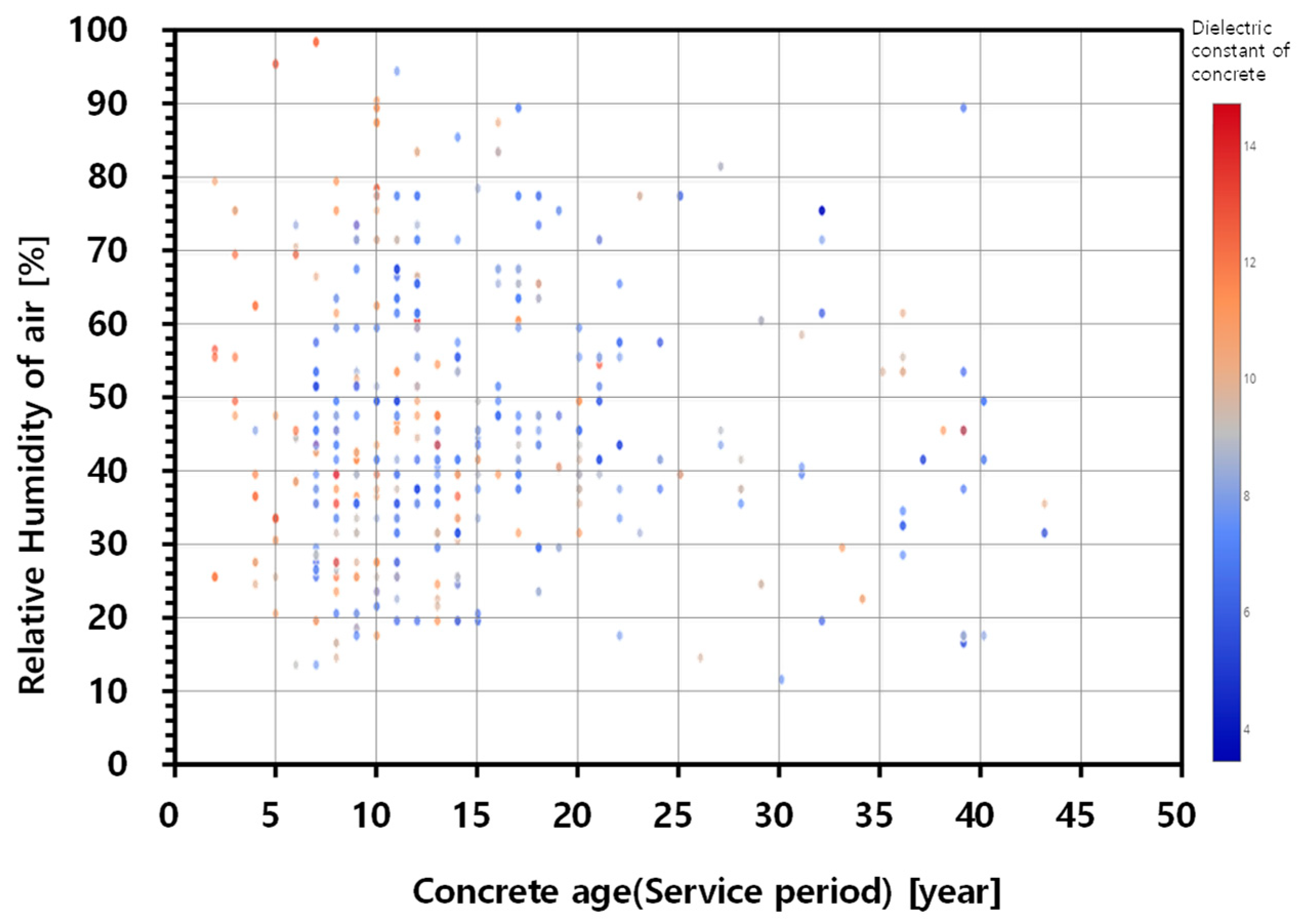
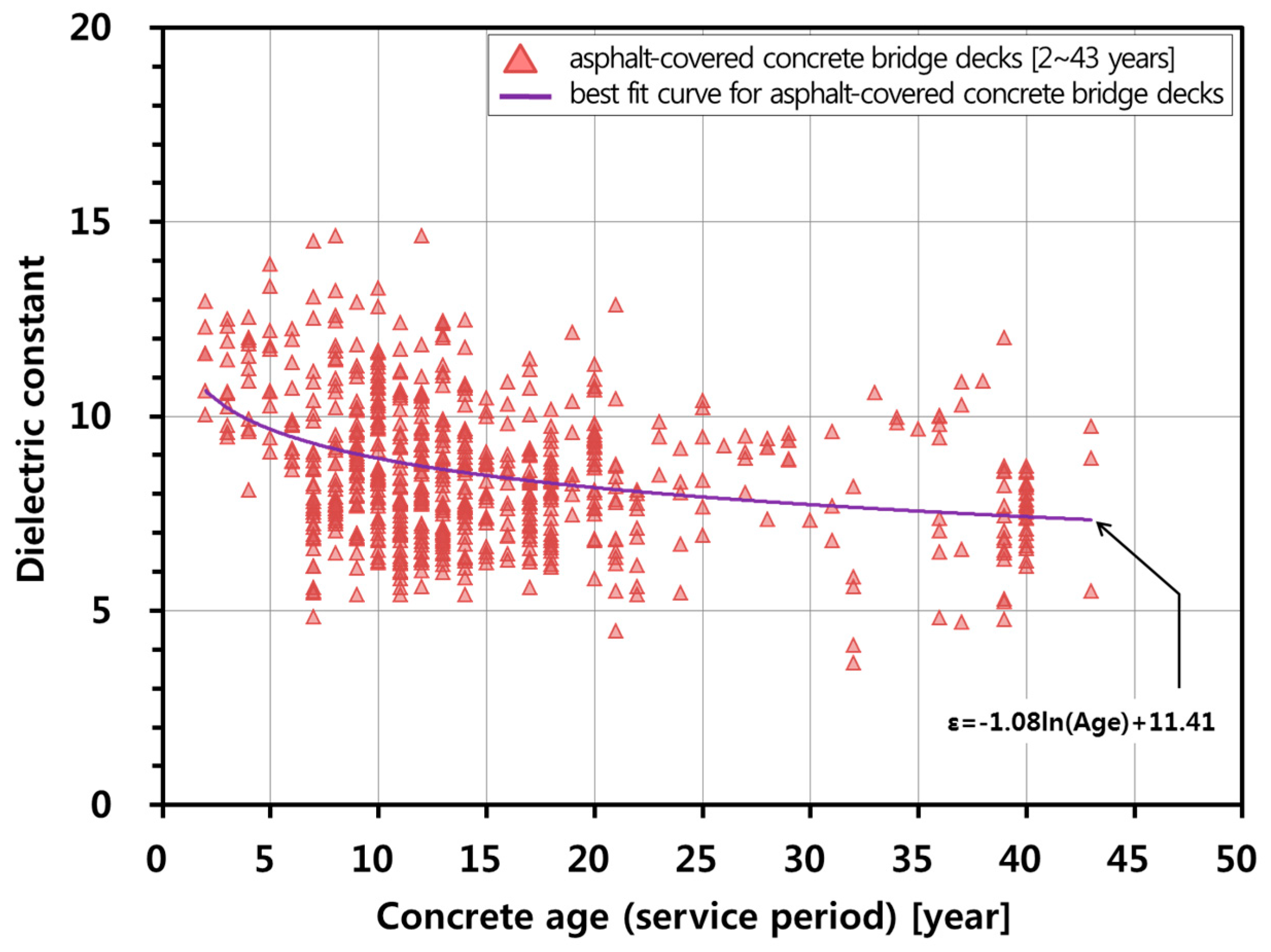


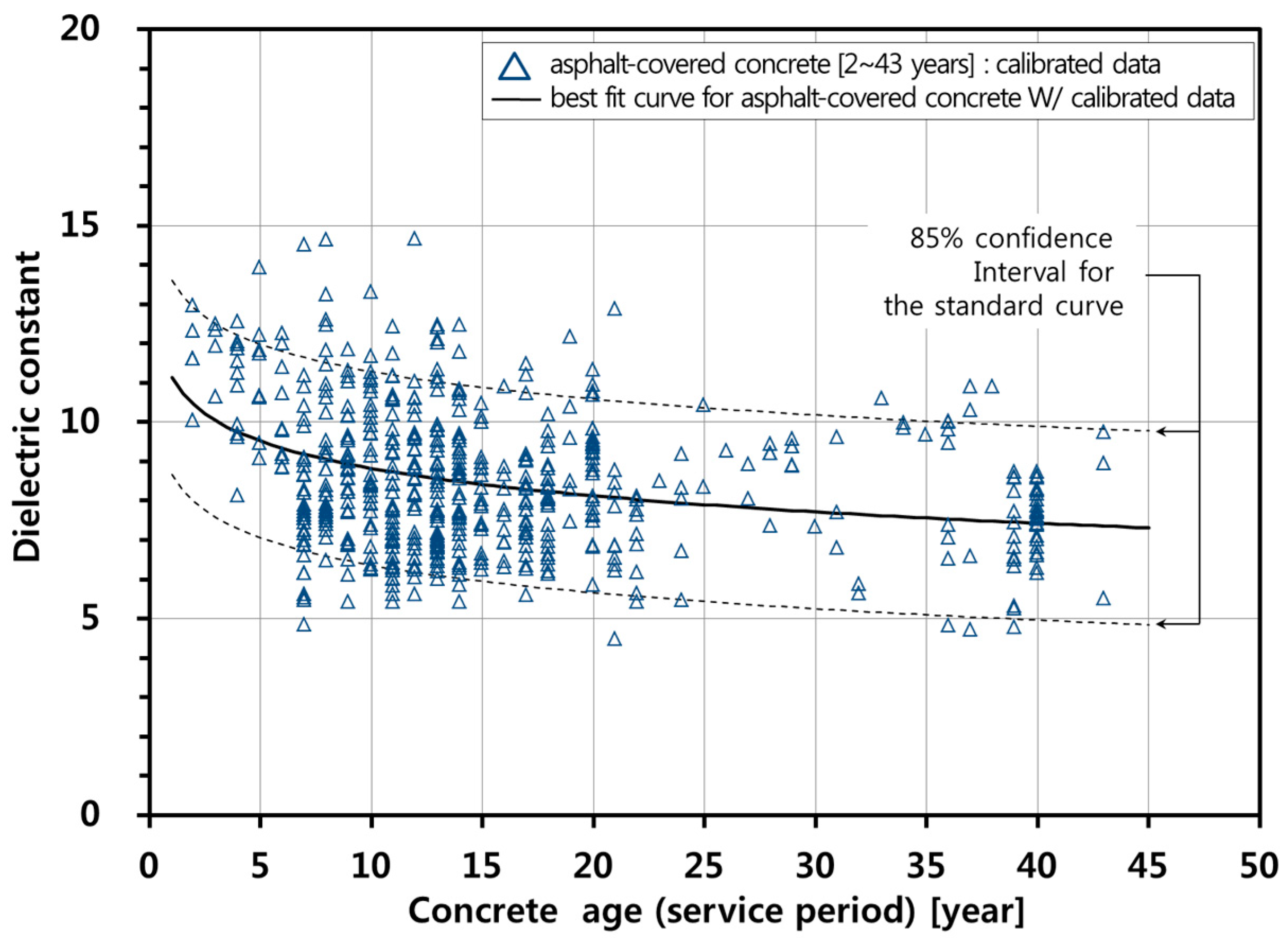
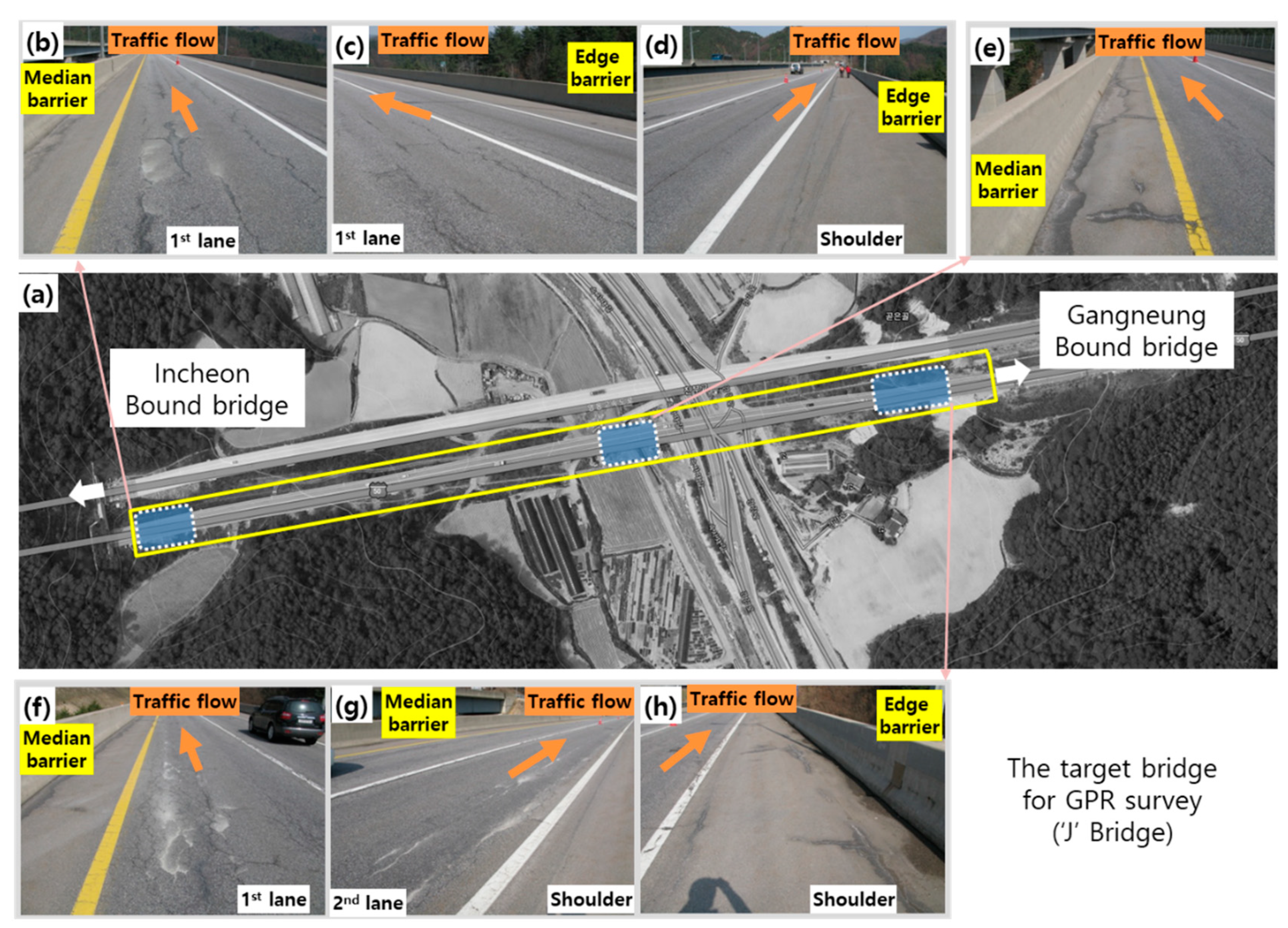
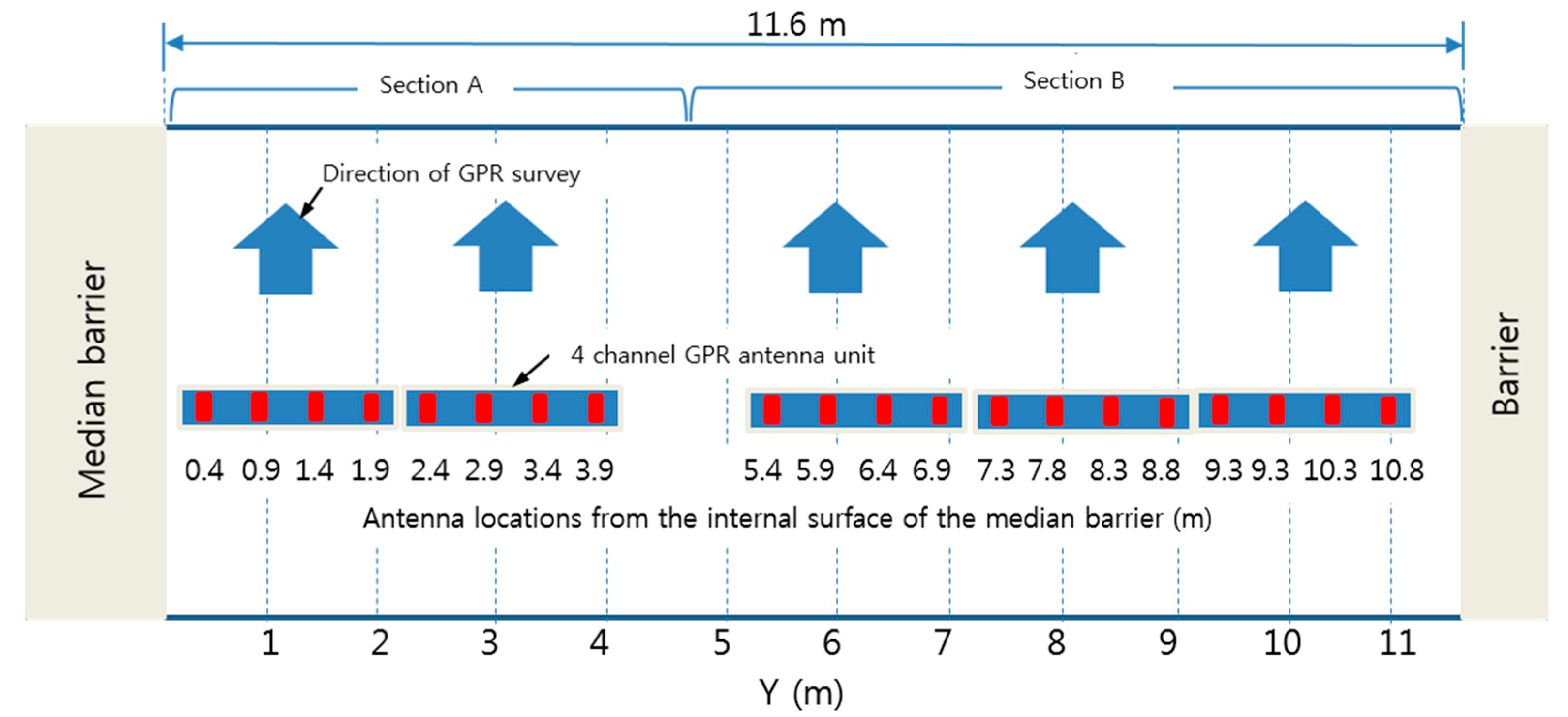
 efflorescence,
efflorescence,  map cracking,
map cracking,  patching).
patching).
 efflorescence,
efflorescence,  map cracking,
map cracking,  patching).
patching).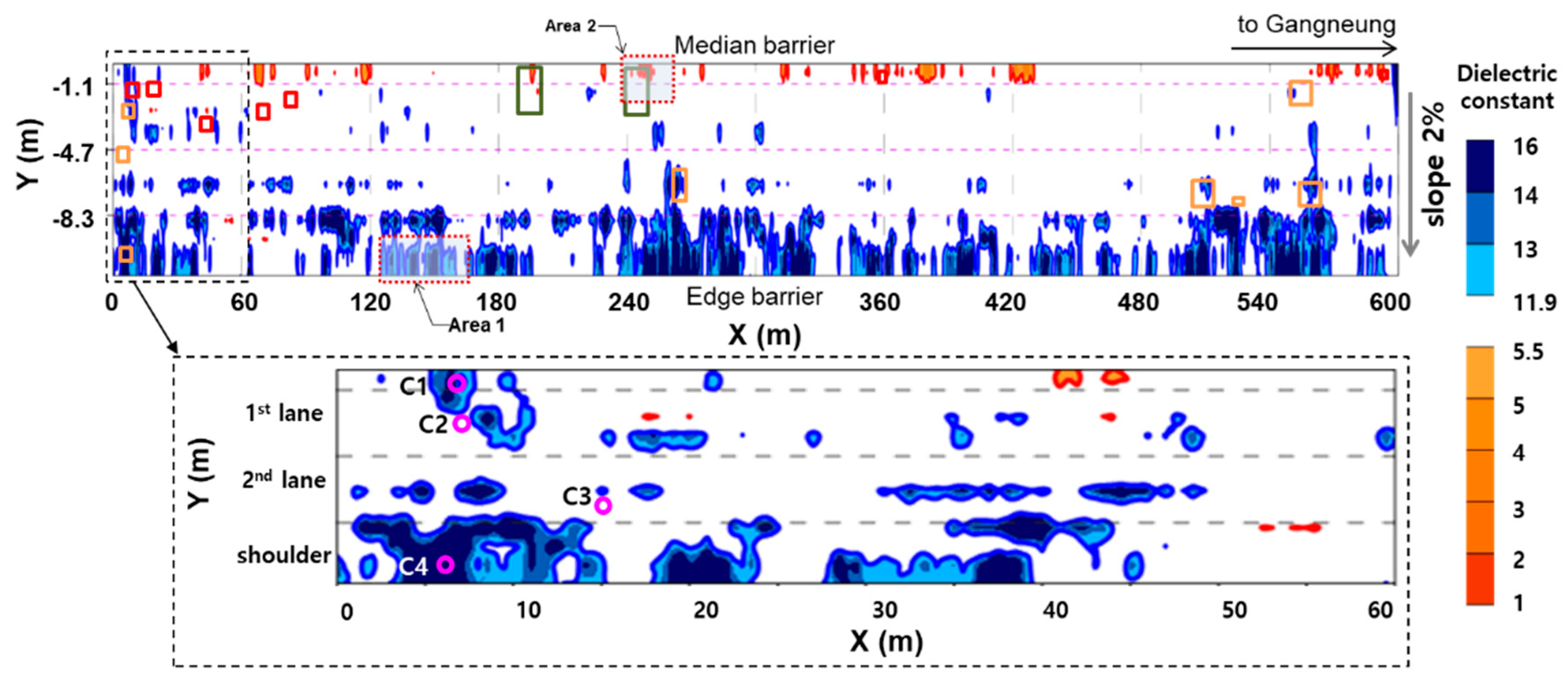
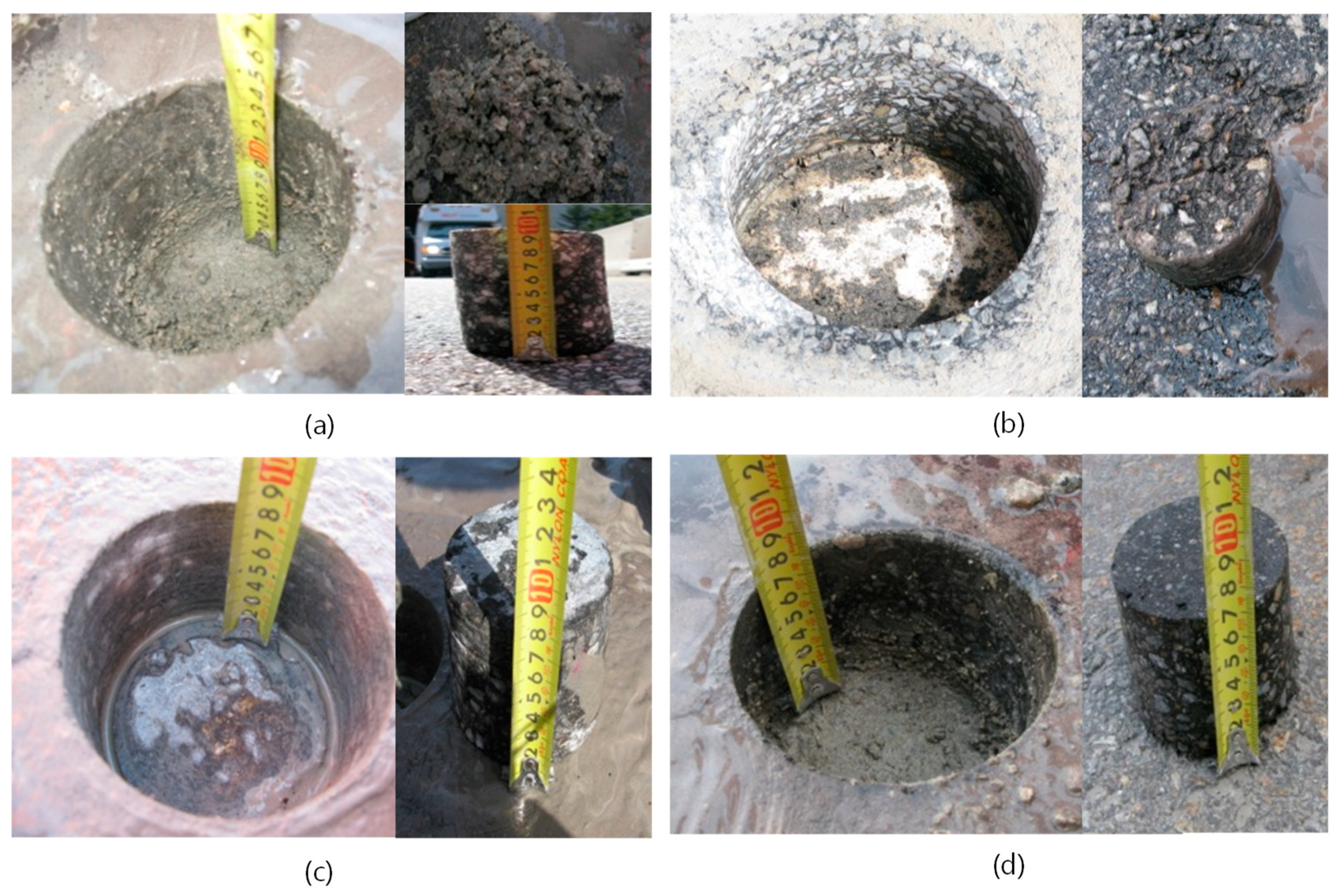
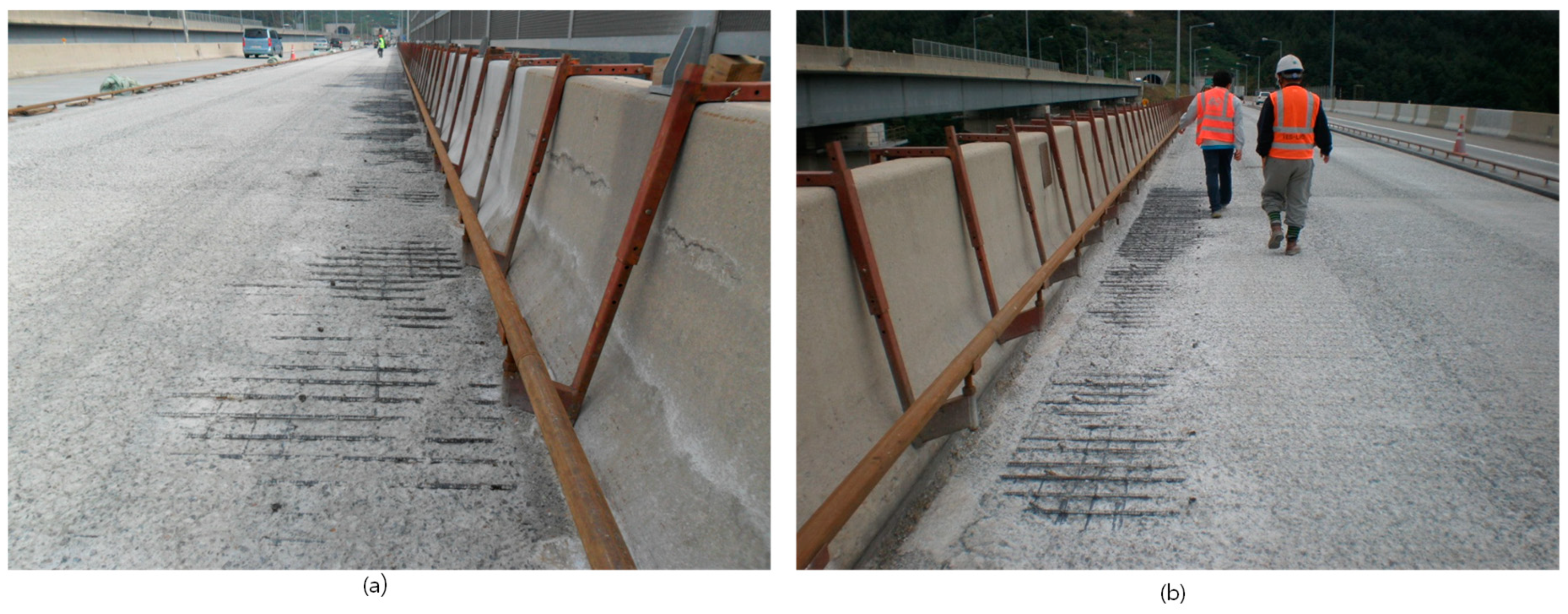
| Route (Expressway) | Bridge Length (m) | No. of Lanes | Survey Year | No. of Bridges | No. of Survey Times | Completion Year |
|---|---|---|---|---|---|---|
| Gyeongbu | 8–505 | 1–6 | ’02–’13 | 137 | 157 | ’69–’70, ’86–’88, ’91–’93, ’95–’96, ’98–’99, ’02,’03, ’06 |
| Yeongdong | 16–780 | 1–4 | ’04–’13 | 102 | 118 | ’71, ’76, ’91, ’94, ’97, ’99, ’00, ’01, ’06 |
| Jungbu | 16–750 | 1–3 | ’06–’13 | 92 | 101 | ’87, ’98–’01, ’05 |
| Honam | 10–603 | 1–6 | ’99, ’04–’06, ’09–’13 | 74 | 87 | ’70, ’73–’74, ’85–’86, ’89, ’92–’93, ’96, ’98–’99, ’02, ’12 |
| Jungang | 11–830 | 1–3 | ’02–’12 | 64 | 82 | ’95–’96, ’99, ’00–’01 |
| Seohaean | 15–710 | 1–5 | ’08–’13 | 56 | 58 | ’94, ’96–’98, ’00–’02 |
| Seoul outer ring | 30–1219 | 1–5 | ’06, ’08–’10, ’12, ’13 | 31 | 36 | ’91–’93, ’95, ’98–’99, ’02 |
| Namhae | 25–331 | 2–4 | ’03, ’10–’13 | 16 | 16 | ’73, ’81, ’83, ’91–’93 |
| Jungbunaeryuk (1) | 10–300 | 2, 5 | ’09–’12 | 12 | 12 | ’78, ’84, ’95, ’02, ’04 |
| Daejeong south | 29–505 | 2, 3 | ’08, ’10 | 8 | 8 | ’00 |
| Pyeongtaek- Jecheon | 24–115 | 3 | ’12 | 4 | 4 | ’02 |
| 88 (2) | 103, 206 | 2 | ’05, ’06 | 2 | 2 | ’84 |
| Donghae | 125 | 2 | ’09 | 1 | 1 | ’01 |
| Ulsan | 175 | 4 | ’04 | 1 | 1 | ’69 |
| Iksan- Pohang | 480 | 2 | ’12 | 1 | 1 | ’01 |
| Subtotal | 8–1219 | 1–6 | ’99–’13 | 601 | 684 |
| Route | Bridge Name | Super-Structure | Completion Year | Location | Length (2) | No. of Lanes | Survey Year |
|---|---|---|---|---|---|---|---|
| Youngdong expressway | J | SBG (1) | 1999 | Pyeongchang | 10@60 m = 600 m | 3 | 2010 |
| Survey Date | Relative Humidity | Season/Weather | Remarks | |
|---|---|---|---|---|
| 8 April 2010 | 51% | Spring/Brume | [Daily temperature] average: −0.7–−3.0 °C highest: −0.9–23.7 °C lowest: −9.5–4.5 °C | [Precipitation] amounts: 0–7.7 mm (rain or snow) days: 9 days note: fog 8 days |
| Classification | Location | Deteriorated Depth (mm) | Dielectric Constant | Remark |
|---|---|---|---|---|
| C1 | Near median | 35 | 13 | Debonding |
| C2 | 1st lane | - | 10 | Bonding |
| C3 | 2nd lane | - | 8 | Bonding |
| C4 | Shoulder | 10 | 17 | Debonding |
© 2020 by the authors. Licensee MDPI, Basel, Switzerland. This article is an open access article distributed under the terms and conditions of the Creative Commons Attribution (CC BY) license (http://creativecommons.org/licenses/by/4.0/).
Share and Cite
Rhee, J.-Y.; Park, K.-E.; Lee, K.-H.; Kee, S.-H. A Practical Approach to Condition Assessment of Asphalt-Covered Concrete Bridge Decks on Korean Expressways by Dielectric Constant Measurements Using Air-Coupled GPR. Sensors 2020, 20, 2497. https://doi.org/10.3390/s20092497
Rhee J-Y, Park K-E, Lee K-H, Kee S-H. A Practical Approach to Condition Assessment of Asphalt-Covered Concrete Bridge Decks on Korean Expressways by Dielectric Constant Measurements Using Air-Coupled GPR. Sensors. 2020; 20(9):2497. https://doi.org/10.3390/s20092497
Chicago/Turabian StyleRhee, Ji-Young, Ko-Eun Park, Kang-Hyun Lee, and Seong-Hoon Kee. 2020. "A Practical Approach to Condition Assessment of Asphalt-Covered Concrete Bridge Decks on Korean Expressways by Dielectric Constant Measurements Using Air-Coupled GPR" Sensors 20, no. 9: 2497. https://doi.org/10.3390/s20092497
APA StyleRhee, J.-Y., Park, K.-E., Lee, K.-H., & Kee, S.-H. (2020). A Practical Approach to Condition Assessment of Asphalt-Covered Concrete Bridge Decks on Korean Expressways by Dielectric Constant Measurements Using Air-Coupled GPR. Sensors, 20(9), 2497. https://doi.org/10.3390/s20092497






